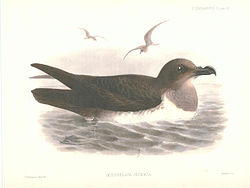| Gadfly petrels | |
|---|---|
 | |
| White-headed Petrel | |
| Scientific classification | |
| Kingdom: | Animalia |
| Phylum: | Chordata |
| Class: | Aves |
| Order: | Procellariiformes |
| Family: | Procellariidae |
| Genus: | Pterodroma Bonaparte, 1856 |
| Type species | |
| Procellaria macroptera (great-winged petrel) Smith A., 1840 | |
| Species | |
About 36, see text | |
The gadfly petrels or Pterodroma are a genus of about 35 species of petrels, part of the seabird order Procellariiformes. The gadfly petrels are named for their speedy weaving flight, as if evading gadflies (horseflies). The flight action is also reflected in the name Pterodroma, from Ancient Greek pteron, "wing" and dromos, "runner".
Contents
The short, sturdy bills of these medium to large petrels are adapted for soft prey that they pick from the ocean surface. They have twisted intestines for digesting marine animals that have unusual biochemistries.
Their complex wing and face marking are probably for interspecific recognition.
These birds nest in colonies on islands and are pelagic when not breeding. One white egg is laid usually in a burrow or on open ground. They are nocturnal at the breeding colonies.
While generally wide-ranging, most Pterodroma species are confined to a single ocean basin (e.g. Atlantic), and vagrancy is not as common amongst the genus as in some other seabird species (cf. the storm petrels Hydrobatidae). Eleven species in this genus breed in the New Zealand region, and six of these are only found there. [1]































